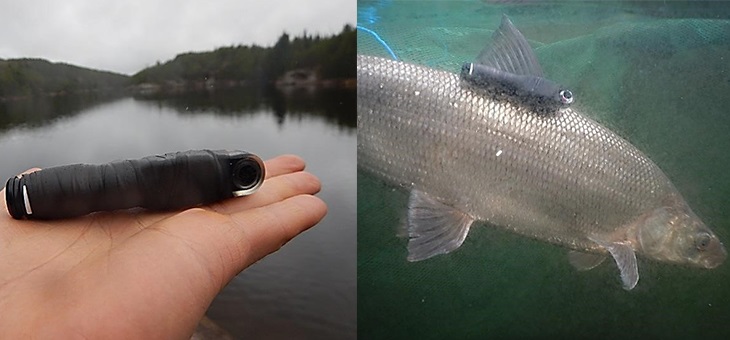Research August 1, 2015
Research Highlights: IISD-ELA Scientists Test Miniature Dissolved Oxygen Acoustic Transmitter
Many fish species require cold, well-oxygenated water to thrive. However, pollution or excess nutrients can result in oxygen concentrations too low to support fish and other organisms. Changes in oxygen concentrations are often hard to detect because aquatic ecosystems are inherently difficult, labour intensive and expensive to monitor using traditional methods. Researchers at McGill University, the University of Manitoba and Vemco have developed a miniature dissolved oxygen acoustic transmitter that can be externally attached to a fish (photo 1), allowing for continual monitoring and reporting of the water quality.
These prototype transmitters are currently being field-tested on lake whitefish (Coregonus clupeaformis) in Lake 658 at IISD-ELA. The transmitters contain sensors to measure depth, temperature and dissolved oxygen in a design capable of fitting in the palm of your hand (photo 2). All three sensors take measurements within a span of 250 milliseconds, allowing the per cent saturation of dissolved oxygen in the water to be calculated, a commonly used indicator of aquatic ecosystem health. The transmitter sensors take measurements approximately every ten minutes for seven months, providing a detailed assessment of oxygen concentrations encountered by lake whitefish in Lake 658.
An array of receivers suspended in the water of Lake 658 detects the acoustic signals (sound waves) sent out by the tags and stores the information. These data are then used to calculate three dimensional positions of tagged fish in the lake over time. The researchers have also surgically implanted other lake whitefish in Lake 658 with small transmitters that measure depth to ensure that the new prototype transmitters do not influence swimming ability. Collectively, the depth, temperature, oxygen and spatial position data will be used to assess the habitat preferences of lake whitefish, an important commercial and sport fish in Canada and the United States. Future research will focus on the development of new sensors to monitor other aspects of water quality, such as contaminants. For more information about the dissolved oxygen tags contact Vemco at do-info@vemco.com.
